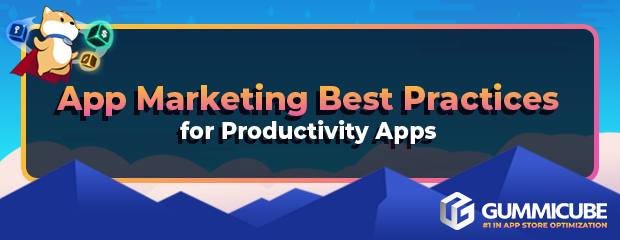Four app marketing best practices for productivity apps
- Friday, August 19th, 2022
- Share this article:
Dave Bell, Co-founder and CEO of Gummicube, looks at the unique challenges of marketing a productivity app in the app stores.
Tags, reminders, schedules, docs – if any of these rings a bell, you may use productivity apps to stay on track with some of life’s busiest moments. The productivity app category is one of the top 3 most popular on the app stores, right behind mobile games and business.
Productivity apps are often called organization apps, too, depending on the feature sets they present. Whatever you may call them, they have undoubtedly made an impact on the way users interact and prioritize their daily tasks.
Organically marketing an app on the app stores in a highly competitive market may be more complicated than you might think. After all, many apps may share similar, if not the same features. Through App Store Optimization (ASO) best practices, cutting through the clutter of the app stores may not only be attainable, but sustainable as well.
Let’s explore some of the ways you can enact an effective mobile marketing strategy for your productivity app.
The Unique Challenge of Marketing a Productivity App
1. Feature Differentiation – To a user, many features may seem like a dime a dozen when they look at the productivity app category. While all apps typically have specialized features they focus on, differentiation can be difficult in this case.
2. Defining a Target Audience – Most productivity apps target demographics in the business, university or education sector. Sometimes it may be difficult to determine which audience base would be the most worthwhile to target with specific features. Reversely, it may be difficult to segment your audience base at all and go for an all-in-one approach.
3. Creative Differentiation – When you look at apps in the category, you may find design elements that are relatively similar in look and feel. It might be difficult to toe the line between best practices and differentiation.
While there are challenges to differentiation in app metadata strategy and creative sets, there are small but impactful ways you can stand out from the crowded app store space.
App Store Optimization (ASO) Best Practices for Productivity Apps
Best Practice #1: Research demand for features
Whether you’re in pre-launch or you’ve already launched your app, researching the demand for your features is an essential step in optimizing visibility. You may find that some features are geared toward a specific audience, whether on a demographic or psychographic classification. Some features may be particularly popular among students, or business professionals. Thus, it’s important to convey these features in a way that resonated with your audience through keyword phrases and creatives that resonate.
Best Practice #2: Scope out the competitor landscape
While a continuous process through ASO, competitor research is especially important in the development, pre-launch, and initial growth stages of your app. Researching competitors in the space gives you more insights as to what works for the category. Developers must effectively strike a balance between differentiation and following metadata and design best practices. Surveying what design elements, calls to action, and tone is all vital, but supplementing your competitor research with ASO technology helps you gear your strategy to be fully data driven. Are competitors using a particular color scheme or design elements? Are they using CTAs that call out specific functionalities? Make note of all of them.
Best Practice #3: Add value through relevant propositions
At the end of the day, users want to know how you can make their lives easier with a productivity app. So how can you deliver that to them effectively? Leveraging brand and framing features in a way that the target audience is the most receptive to them is a great way to attract and retain high-quality users. Oftentimes, features must be tailored to your target audience as features can’t necessarily speak for themselves and what type of value they bring to their needs. Apply your features situationally and directly address your solutions.
Best Practice #4: Adjust for seasonality and iterate regularly
The app stores reward developers that keep their apps fresh. Whether it be through iteration or seasonality, being able to apply different growth tactics to increase visibility and downloads is important. This not only lets you convey relevance during seasonal events like back to school, but through iteration, you’re able to highlight any variances in search patterns and creative set changes that may be more effective on the app stores.
Overall
Productivity apps help users all around the world focus on what matters most. Delivering value is important in marketing your app. When faced with the issue of differentiation, you have to use the best resources available to implement an ASO strategy that enables you to stand out. Provide value to your users at every step from reach to installs to attract high-quality users to successfully market your app organically.
About the Author
Dave Bell is Co-founder and CEO of Gummicube. Gummicube is a global leader in App Store Optimization with more than 12 years of experience optimizing and marketing apps. We offer the leading enterprise ASO technology and agency services, providing support to clients around the world. Our company is trusted by thousands of enterprise brands and leading startups including Microsoft, LinkedIn, Bethesda, SWEAT, GrubHub, McAfee and many others.

















